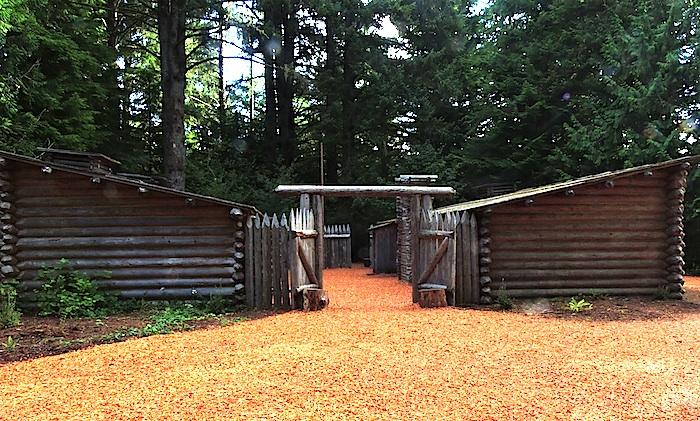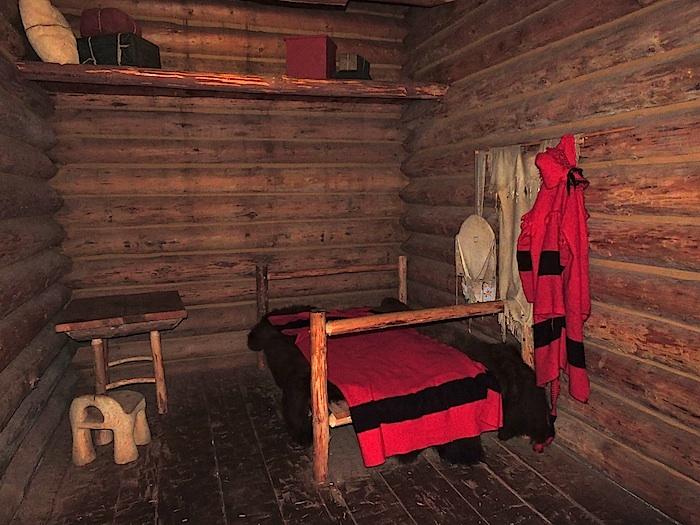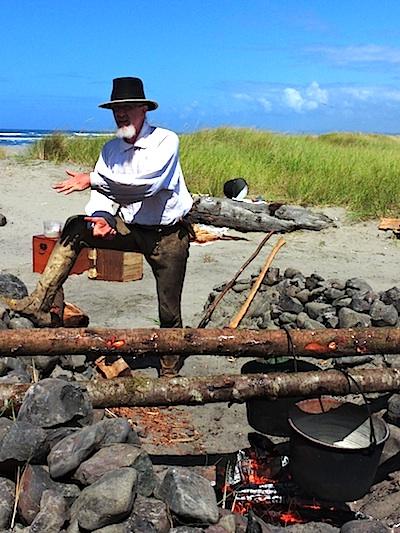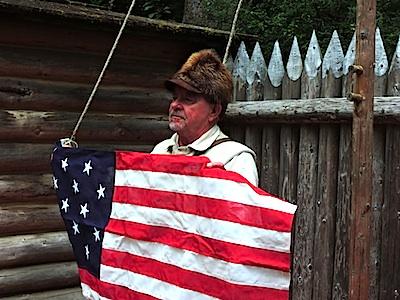
A replica of Fort Clatsop greets visitors at Lewis and Clark National Historical Park/Lee Dalton
I’ve just returned from a delightful day-and-a-half. The kind of days that left me thinking now this is the way all National Park Service interpretation should be.
It was raining when I got to Lewis and Clark National Historical Park on the coast of Oregon and Washington. Since I’ve recently had enough rain to keep me satisfied for a good long while, I didn’t go out to the replica of Fort Clatsop where Captains Meriwether Lewis, William Clark, and the rest of the Corps of Discovery spent an uncomfortable three months during the winter of 1805 and 1806. Instead, I stayed inside and read every one of the many display panels in the museum that tell their tale.
I’ve always been fascinated by the story of Lewis and Clark, Sacagewea, and her baby and all the others who traveled west at the request of our third president, Thomas Jefferson. It’s been a long time since I read most of their journals, and I found I’d forgotten some details. The museum did a fine job of bringing them back and added a few things I don’t think I ever knew.
There have been a lot of changes at this place since my family and I visited here perhaps 20 years ago. The visitor center and museum are new. The present replica fort replaces the one that was here then. Fire destroyed the original replica. The parking lot is much, much larger than the one I remember. It had been full and overflowing a little during the first day of my visit. Passengers from a big tour bus roamed the museum and made it a bit difficult to read display captions without waiting awhile.
That’s why I was sure to arrive at the center’s front doors right at nine the next morning. Good move. The parking lot was almost empty. The sun was shining. I was greeted at the desk by a friendly volunteer and headed straight for the trail to the fort. There I was met by Jim Reeves, a volunteer interpreter who was about to raise the flag bearing 15 stars and 15 stripes on the pole at one end of what the captains called the parade ground in the middle of the fort. After a short talk about the history of that particular flag – the second American flag since two states had been added since the original 13 – Jim raised the flag and the day’s duties at the fort were ready to begin. Jim finished his talk by welcoming the six visitors who had been there early and then said, “Remember, this is your national park. It really is America’s Best Idea. Enjoy it and protect it.”

A typical "bedroom" at Fort Clatsop/Lee Dalton
Inside the captains’ room I found volunteer Larry Frei laying out thick paper, quill pens, and powdered ink so visitors could try their hands at writing and drawing with feather quills as the captains and the soldiers who were able to write had done when they were here.
When I came back later in the day I found a girl of about ten trying her best to write without blotting her work. She finally looked at what she’d done and called out to everyone around, “That was really hard! They must have practiced a lot.”
Her mother stood by snapping pictures by the score with a cell phone and said, “Yes, but it’s all they had back then.”
A young girl of the 21st century was guided to a discovery of her own by the Corps of Discovery of the Nineteenth Century.
I eavesdropped outside as Jim Reeves answered questions about the fort and its construction. Some visitors wanted to know how we knew what the fort had looked like. Jim explained that Captain Clark left a floor plan sketch in his journal and the Park Service had constructed it to that plan and the dimensions of 50-by-50 feet with a 20-foot parade ground in the center. Then he added that it’s pretty certain the original fort had not been anywhere near as polished and well-made as this replica.
“It wasn’t built to Park Service standards,” he said.

Making salt for the Corps of Discovery was a round-the-clock job/Lee Dalton
The original fort was constructed in less than two weeks. With hand tools, of course. “They were motivated,” he said. “After all, they’d been sleeping out on the ground in the rain.”
As for other details? Were there really beds and benches and desks and other furniture in the first fort? Did Charbenau and Sacagewa actually have a double bed? No one knows, but I have a very strong hunch that the original was nowhere near as fancy as this one. Is there a tendency to try to idealize history when we attempt to reconstruct the past?
When asked about details like that, Jim says, “They are based on what I call ‘informed speculation.’” But he points out that at least one member of the expedition was a master carpenter. He adds, too, that even though the only description of the fort in any of the journals is that sketch of the floor plan, the fort follows the pattern of other frontier forts of the time.
“Think of it,” he remarks, “those people knew how to work, and work hard. These were soldiers. Disciplined and tough. Could they have built something like this? Perhaps . . . “
One detail the Park Service omitted – deliberately – were the fleas that made life so miserable for the men of the Corps. Missing today, too, was cold winter rain. Of the 106 days the discoverers spent at Fort Clatsop, it rained for 94.
The Saturday of my visit was a special day. It was the day when the Saltmakers returned to the beach where the Corps had boiled sea water. About 15 miles southwest of the fort, where the town of Seaside now stands, a bunch of NPS volunteers and volunteer members of the Seaside Museum & Historical Society, the city of Seaside, and a crew of others had gathered to reenact the process. Simple, really. Gather a gallon or two of seawater and boil it down in a large “kittle” as was written in a journal. Three of the expedition’s men spent weeks working 24 hours a day. They had to travel a long way down the beach to find salt water that had not been diluted by water from the Columbia River.
Meriwether Lewis wrote on February 3, 1806, that “we find it a very tedious opperation, that of making salt, notwithstanding we keep the kittles boiling day and night. we calculate on three busshels lasting us from hence to our deposits of that article on the Missouri.”
They needed salt to preserve meat and fish caught here for the trip back to St. Louis.
While at the saltworks, I met interpretive Ranger Sally Freeman. She’s the park’s coordinator of volunteers. When I remarked how impressed I’d been of the volunteers all around at the salt works and back at the fort, she said that many of them have been volunteering for years. She pointed out two men at the salt works who had each been doing this for upwards of 16 years.
I asked about a comment made by another volunteer back at the fort who had said she thought much of the park’s successful interpretive program is because both Sally Freeman and chief interpreter Jill Harding have been here most of their NPS careers – 26 and 25 years. Sally agreed.
“We’ve been able to build very strong relationships with the community and organizations like the museum society, the cities of Astoria and Seaside, and people like these who give so generously of their time.”
It was this long service that has allowed the volunteers to develop such great depth of knowledge.
I asked about a comment by a volunteer I hadn’t understood. He’d remarked that the reenactments are no longer first-person, but are now done in third-person. It sounded as if some kind of copyright issue was involved. Sally said the reason is simple. It’s almost impossible throughout the Park Service to find reenactors who match the characters they portray. At Fort Clatsop, they really need young, tough, lean, muscular men. I looked around and immediately understood the point. Not to take anything away from the people who give their time and talent as volunteers, but none of those I saw today came anywhere near close to resembling the men of the Corps.
I asked a question that is sometimes hard for NPS employees to answer. What about the superintendent? Sometimes, upon asking that question, there’s an awkward pause as the poor person tries to find a way to be very, very diplomatic. Not so this time. Superintendent Scott Tucker has been here only a couple of years, but according to Sally and some others, he’s a sparkplug who provides full support for all their efforts.

Jim Reeves raises the Stars and Stripes -- 15 stars, 15 stripes -- at Fort Clatsop/Lee Dalton
One long-time seasonal said, “I really like him. He’s right here with us. I’ve worked for some superintendents in other places who were aloof and distant. But Scott knows us by name and is always ready to listen to our concerns and ideas.” Another person said Scott’s background is interpretation.
I think it shows.
It was also interesting to learn that there is no law enforcement ranger at this site. The county sheriff’s deputies will respond if needed. “But I don’t recall any time we’ve needed them in all the years I’ve been here,” Sally said.
Back at the fort, I caught a second black powder musket demonstration by seasonal ranger Larry Cooper. He told us of the three kinds of firearms carried by the expedition and explained the difference between a musket and a rifle. Lots of good humor, and he enlisted a few young visitors to come up and examine the musket he was holding as he explained how it worked.
As he explained the weapons, he also managed to weave in just about the entire story of how the expedition came about and how it had reached the place where they built the fort. As he answered visitors’ questions, I found myself watching in admiration as I realized what a great depth of knowledge he has.
Then, with help from volunteer safety officer Larry Feith, he loaded the musket and made a big noise.
When he finished, he reminded us all that this is OUR national park. America’s best idea and ours to support and protect.
Inside, however, I felt a little sick because I’d heard earlier that this will be Larry Cooper’s last season at Fort Clatsop. It seems that Ohio’s new health-care laws will prohibit him from working outside the state if he wants to keep his coverage. The ugly hand of political game playing reaches out to rob this park of a gifted interpreter.
Finally, I ended my day with Lewis and Clark by listening in as Jim Reeves lowered the flag, told its story to another bunch of visitors with help from two young brothers he’d recruited to help fold the flag. Again, he ended his talk with that line: “This is one of YOUR national parks. Enjoy it. Protect it.” Then he added, “And maybe write to your representatives in Congress asking them to support the parks.”
Give that man a high five. Heck, let’s give him a high ten and a fist bump, too.
This, to my way of thinking, is what all NPS interpretation should be. I left Fort Clatsop smiling from ear to ear and very proud to once have been a part of this greatest idea.
To Jim and his wife, to Larry and Larry, to Scott and Jill and Sally and all the volunteers, to all the maintenance workers who keep the place clean and toilets flushing, THANK YOU FOR KEEPING THIS PART OF AMERICA’S BEST IDEA UP AND RUNNING.



Add comment